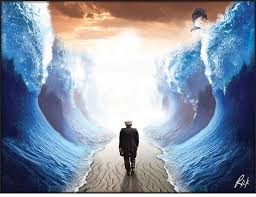Seven days after the Exodus the Israelites stood at the edge of the Reed Sea. The Egyptians were closing in from the back and the desert was closing in on the sides, and they cried out in fear.
The Mechilta describes that as they stood at the shore of the sea, the people of Israel split into four factions. One faction said: “Let us cast ourselves into the sea.” A second faction said, “Let us return to Egypt.” A third said, “Let us wage war against the Egyptians.” A fourth said, “Let us cry out to G-d.”
“And Moshe said unto the people: Fear ye not, stand still, and see the salvation of HaShem, which He will work for you today; for whereas ye have seen the Egyptians today, ye shall see them again no more forever. HaShem will fight for you, and you shall hold your peace.” (Exodus14:13-14)
To those who said, “Let us cast ourselves into the sea,” like those in our days who foresee doom and gloom in a state of Israel surrounded by enemies, he said: “Fear not; stand by and see the salvation of G-d.”
To those who said, “Let us return to Egypt,” like those in our days who consider returning to Germany, France and to exile in general, he said: “As you have seen Egypt this day, you shall not see them again any more forever.”
To those who said, “Let us wage war against them,” like those who arrogantly boast of their strong armies and weapons, he said: “G-d shall fight for you.”
And to those who said, “Let us cry out to G-d,” like those that wait in prayer and are afraid step in and be active, said: “And you shall be silent.”
Yet Hashem takes it to a different level. As in all critical steps in Hashem’s plan He waits for a “stirring from below” to then bring about the “stirring from above” . “And HaShem said unto Moshe: Why are you crying out to Me? Speak unto the children of Israel that they go forward.” (Exodus14:15).
But who then would make the first move? At that moment, the leader of the tribe of Judah, Nachshon ben Avinadav makes a critical and impactful decision.
The Talmud (Sotah 37a) and the midrash ( Shemot Rabbah) describe his courage and determined step into the unknown when he saw that the tribes were uneasy about which one would be the first to enter the sea.
Nachshon Jumped in and the people soon followed and as a result the sea split open.
Who then was Nachshon ben Aminadav?
Nachshon was a fifth-generation descendant of Judah, son of Jacob. His father was Aminadav, son of Ram, son of Chetzron, son of Peretz, son of Judah. (1 Chronicles 2:4–10)
He appears for the first time in the Torah when Aaron marries his sister. “Aaron took for a wife Elisheva, daughter of Aminadav, sister of Nachshon.” (Exodus 6:23)
Furthermore we become aware of his great stature in a later description. Nachshon was appointed by Moses, upon G d’s command, as prince and military commander of the Tribe of Judah, and, although his tribe was fourth in the order of the Patriarchs, at the dedication of the Tabernacle he was the first to bring his dedicatory offering ;
“The chieftains brought [offerings for] the dedication of the altar on the day it was anointed; the chieftains presented their offerings in front of the altar. The Lord said to Moses: One chieftain each day, one chieftain each day, shall present his offering for the dedication of the altar. The one who brought his offering on the first day was Nahshon the son of Amminadab of the tribe of Judah.and is enumerated as one of the “heads of their ancestral houses, the leaders of the tribes.” (Numbers 7:10-12)
Yet it is the courage of Nachshon that would be a prototype for all his descendants
In general it is the Jewish understanding that the Exodus from Egypt would be the prototype of the ultimate redemption. “What was” becomes the picture of “what will be”. In the words of the Ramban, “Maaseh Avot Siman LeBanim” (Ramban ; Genesis 12:6), the actions of the forefathers become signposts for their children in their own journey.
The spiritual ingredient which heralded the miracle and tore the sea apart was the fact that the people simply “went forward. That is what Hashem awaits in our generation
We are living in a generation torn between those who want to appease and those who take frantic action without concern for implications and morality.
The time before the final redemption is termed Hevlei HaMashiach translated as the birth pangs of the messianic redemption. Yet the word Hevlei can also be translated as the “rope ” of the Mashiach.
These days wherein human history seems to be tumbling forward in a frantic and uneven pace is likened to a tightrope connecting our past and our future. A walk on such a rope necessitates a delicate walk that on the one hand depends on Hashem’s sovereignty and involvement and on the other depends on taking faithful and considered action.
That type of walk is the essence of Nachshon ben Aminadav’s delicate walk. It is through Nachshon that the genetic DNA and spiritual impact will have eternal implications.
The sons of Nachshon ben Avinadav were Elimelech, Shalmon (the father of Boaz), Ploni Almoni (Tov) and the father of Naomi. (Bava Batra 91). That is to say that Elimelech the father in law of Ruth was the son of Nachshon. Yet so was Shalmon the father of Boaz, a son as well.
“And the women neighbors gave him a name, saying, ‘A son has been born to Naomi,’ and they called his name Obed – he is the father of Jesse, the father of David. And these are the generations of Perez: Perez begot Hezron. And Hezron begot Ram, and Ram begot Amminadab. And Amminadab begot Nahshon, and Nahshon begot Shalmon. And Shalmon begot Boaz, and Boaz begot Obed. And Obed begot Jesse, and Jesse begot David.” (ibid. 17-21)
LeRefuat Yehudit bat Golda Yocheved

